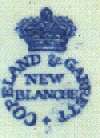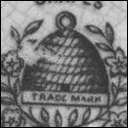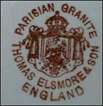![]()
A simple guide to understanding the basics of the marks and dates on the
underside of pottery.
|
Why the marks are important: |
|
![]()
|
How marks are
applied: |
|
|
(a) Incised (b) Impressed (c) Painted (d) Printed |
(b) Impressed into the soft clay during
manufacture, many name-marks such as 'Wedgwood' are produced in this way from
metal or clay stamps or seals. These have a neat mechanical appearance. (c) Painted marks, usually name or initial
marks, added over the glaze at the time of ornamentation, as were some stencilled
marks. (d) Printed marks transferred from
engraved copper plates at the time of decoration. Most 19th-century marks are
printed, often in blue under the glaze when the main design is also in
underglaze blue. Information on the method of applying each mark can be of vital importance, for instance the early Chelsea triangle mark must be incised not impressed, as it can be on 19th-century fakes. |
|
General Rules
for dating marks: |
|
|
|
(2) Pattern Name:- Printed marks incorporating the name of the pattern are after 1810. (3) 'Limited' Company Marks incorporating the word 'Limited', or the abbreviations 'Ltd', 'Ld', etc., denote a date after 1861, and most examples are much later. (4) Trade
Mark:- Incorporation of the words
'Trade Mark' in a mark denotes a date subsequent to the Act of 1862. (5) Royal:- Inclusion of the word 'Royal' in a firm's title or trade name suggests a date in the second half of the 19th century, if not a 20th-century dating. (6) Registered number:- Inclusion of the abbreviation R N' (for Registered Number) followed by numerals denotes a date after 1883 (see Registration numbers). (7) 'England':- Inclusion of the word 'England' in marks denotes a date after 1891, although some manufacturers (Thomas Elsmore & Sons for example) added the word slightly before this date. 'Made in England' denotes a 20th-century date.
(8) Bone China:- Use of the words 'Bone China', 'English Bone China', etc., denotes a 20th-century date. (9) Descriptions:-
Use of words of description such as "Ye Olde Willow"
"Genuine Staffordshire Ware" "Victoria Ironstone" and the
like usually indicate modern copies. |
![]()
Back to Pottery
- Ceramic Trade Marks
![]()
Questions and comments to:
Steve
Birks
updated:
7 September 2004





